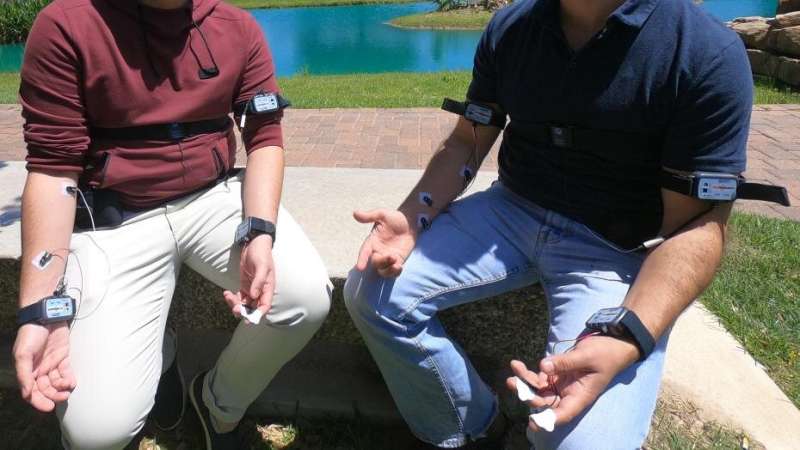Wearable technology measures mental activity through the skin

Researchers at NYU Tandon have reached a key milestone in their quest to develop wearable technology that manages to measure key brain mechanisms through the skin.
Rose Faghih, Associate Professor of Biomedical Engineering, has been working for the last seven years on a technology that can measure mental activity using electrodermal activity (EDA)— an electrical phenomenon of the skin that is influenced by brain activity related to emotional status. Internal stresses, whether caused by pain, exhaustion, or a particularly packed schedule, can cause changes in the EDA—changes that are directly correlated to mental states.
The overarching goal—a Multimodal Intelligent Noninvasive brain state Decoder for Wearable AdapTive Closed-loop arcHitectures, or MINDWATCH, as Faghih calls it—would act as a way to monitor a wearer's mental state, and offer nudges that would help them revert back to a more neutral state of mind. For example, if a person was experiencing a particularly severe bout of work-related stress, the MINDWATCH could pick up on this and automatically play some relaxing music.
Now Faghih—along with Rafiul Amin, her former Ph.D. student— has accomplished a crucial task required for monitoring this information. For the first time, they have developed a novel inference engine that can monitor brain activity through the skin in real time with high scalability and accuracy. The results are featured in a new paper, "Physiological Characterization of Electrodermal Activity Enables Scalable Near Real-Time Autonomic Nervous System Activation Inference," published in PLOS Computational Biology.
"Inferring autonomic nervous system activation from wearable devices in real-time opens new opportunities for monitoring and improving mental health and cognitive engagement," according to Faghih
Previous methods measuring sympathetic nervous system activation through the skin took minutes, which is not practical for wearable devices. While her earlier work focused on inferring brain activity through sweat activation and other factors, the new study additionally models the sweat glands themselves. The model includes a 3D state-space representation of the direct
secretion of sweat via pore opening, as well as diffusion followed by corresponding evaporation and reabsorption. This detailed model of the glands provides exceptional insight into inferring the brain activity.
The new model was run on data from 26 healthy individuals. The researchers showed that they can decipher brain signals with high reliability. Additionally, the computational power requirement of their new algorithm is minimal and can obtain brain and physiological insights within a few seconds whereas another previous approach would take minutes. This means that small, wearable monitoring technology capable of incredible speed, high scalability, and extraordinary reliability is within reach.
The broader impact and applications of the methodology includes performance monitoring, mental health monitoring, measuring pain and cognitive stress. Mental health tracking can help better manage autism, post-traumatic stress disorders, excessive irritability, suicidal tendency, and more. Performance tracking and cognitive stress tracking can help improve individual productivity and quality of life.
"One's performance changes based on their cognitive engagement and arousal levels." says Faghih. For example, very low or very high levels of arousal can result in poor performance. Hence, it is expected that. Ultimately, researchers can utilize the inferred autonomic nervous system activation and decoded arousal to develop interventions for improving productivity."
One example application of this method is early diagnosis of disorders like diabetic neuropathy. Small nerves transmit brain stimulation to many parts of the body, including those linked to skin conductance response. To track the received brain activity, EDA may be measured and monitored on a regular basis in neuropathy-prone skin areas of the body. If a skin area has neuropathy (i.e., tiny nerves have been damaged), the brain will not activate that area. By monitoring changes, doctors can see how a condition like diabetic neuropathy progresses, and can lead to changes in treatment plans.
Another example is a newborn patient in extreme pain following a surgical procedure, who cannot convey their degree of suffering. Doctors may use EDA recordings and infer brain activity to assess how much pain the infant patient is in and intervene as needed.
For Faghih, this work could represent a breakthrough for mental health care. Monitoring the mental status of vulnerable people could help them get more effective care and prevent severe consequences from declining mental health or swings in mood.
Her team is now working on ways to incorporate the model into wearables, including the elimination of informational "noise" caused by factors like robust movement and exercise, as well as seeking potential partnerships to design and manufacture the devices that would carry the algorithm.
More information: Rafiul Amin et al, Physiological characterization of electrodermal activity enables scalable near real-time autonomic nervous system activation inference, PLOS Computational Biology (2022). DOI: 10.1371/journal.pcbi.1010275




















